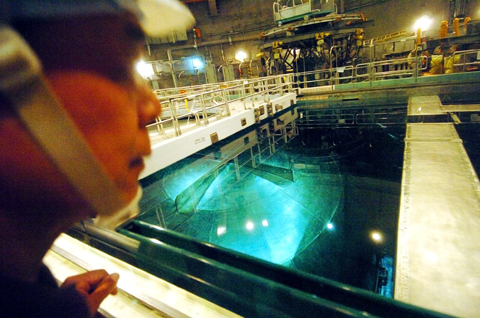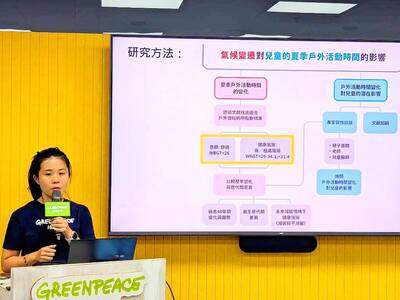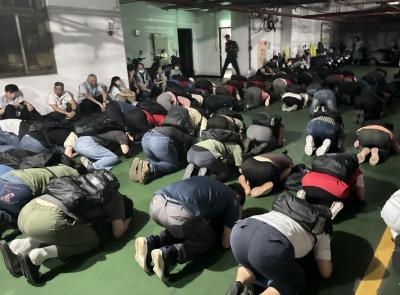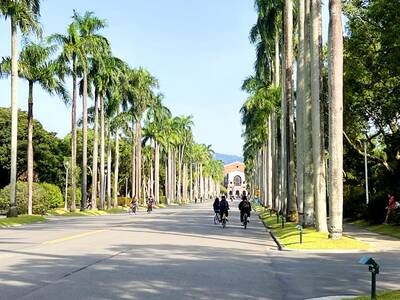Taipei Times: Do you believe nuclear power can solve the world energy crisis?
Ian Lowe: If nuclear energy was the only way of preventing climate change, we should grit our teeth because the most optimistic studies — like the ones by the International Energy Agency — looking at how the world can reduce carbon emissions by at least 60 percent by 2050 looked at a range of scenarios. Even in the scenarios that did include nuclear power, it only accounted for 6 percent of the carbon emission reduction by 2050, with about 45 percent coming from other technologies and about 50 percent from improved efficiency.

PHOTO: CHANG CHIA-MING, TAIPEI TIMES
TT: There is a belief that nuclear energy is the only source that can generate enough output to meet future demand, since wind and solar power are less reliable. Do you agree?
Lowe: About 10 years ago it looked like the nuclear power industry was dying, until [people] had this idea of revamping it as the solution to climate change. On one level it is valid to say that if the 456 nuclear reactors that are contributing to 15 percent of the world’s energy had not been operating, and instead we were burning coal to produce that energy, there would be more carbon dioxide in the air.
On another level you could equally say if that 15 percent of the energy was coming from wind turbines or solar energy, there would also be less carbon in the air. If you saw nuclear power as the answer, you would have to address [the fact] that uranium is also a limited resource.
There is enough high-grade uranium to keep the present nuclear reactors running for about 50 years, and they supply 15 percent of the world’s electricity. Nuclear energy is not renewable because it is depleting non-renewable resources like uranium. Some say it’s clean energy, but I think something that produces waste that lasts a million years isn’t very clean. There are talks about a new generation of nuclear energy that will be cleaner, but they have talked about it for 50 years.
Energy studies looked at what happens if we exhaust the high grade uranium ores and move to the low grade ones, and found that would produce as much carbon as burning gas because it would require digging and crushing rocks to extract the uranium. I don’t think nuclear [power] is an answer to the problem, particularly if you see an increase in energy demands in the future. While solar energy can’t be stored now, there are other renewable energies including wave and geothermal that are available 24 hours a day. But any form of renewable energy [is] variable, so it doesn’t make sense to rely on any one of them.
In the future the energy plant will be one that uses solar energy when there’s sun, wind turbines when there’s wind, and geothermal and wave at other times. Quoting [former US vice president] Al Gore, I say there isn’t a silver bullet, but there is silver buckshot; there isn’t one solution, but there are lot of little things that together solve the problem.
TT: How do you think a balance between environmental protection and economic development can be achieved?
Lowe: We should be doing social-environmental-economic analysis of all proposed new developments. At the moment we do very vigorous economic assessments, quite superficial environmental assessments and no social assessments at all. It’s obvious any significant development has environmental and social impacts; the issue of whether they are acceptable is a social value judgment.
In most political systems up till now, the presumption has been that any project that is economically viable should go ahead, unless there is undeniable evidence that there will be major environment damage. My view is that our fundamental duty to future generations is to maintain the integrity of natural systems.
TT: Do you feel that major nations left out of the Kyoto Protocol, such as the US and China, should begin to make reduction pledges?
Lowe: The second stage of the roadmap established at Kyoto, which will be negotiated in 2009 in Copenhagen, will be arrangements for the period 2012 to 2020. That would need to involve significant reduction in emissions from the developed countries.
The Kyoto roadmap was that the third stage would be the developed countries having shown their preparedness to reduce significantly, would be in a position to persuade the developing countries to set targets of significantly lowering emissions.
The US is certainly covered by the Kyoto Protocol, although the [former US president George W.] Bush administration didn’t ratify it, but China, India and Brazil were not targets of Kyoto.
Politically and morally that was correct, because at the time of the Kyoto meeting more than 80 percent of the carbon in the air came from the developed countries, and the first step had to be for them to stop increasing their emissions.
In terms of how we are going to go forward from here, if you looked at the carbon that is going into the air now, the US and China each account for about a quarter. Most other countries are not responsible for more than 2 percent, [so] there isn’t going to be a workable agreement unless the US and China are part of it.
Post-2020, the agreement certainly has to involve China. I heard ... that diplomats are trying to arrange a meeting between [US President Barack] Obama and the Chinese leaders because they have a shared interest in having a global arrangement. If they did reach an agreement, it would greatly encourage the countries that are responsible for the other half of the world’s emissions to make reduction efforts.
TT: Should countries like Taiwan expect to be demanded to make a contribution in the near future?
Lowe: If the roadmap is followed, after 2020 all countries will be part of the global arrangements to reduce carbon. 2020 is in 10 years. That means if countries like Taiwan were planning to build a coal-fired plant, for example, it is likely to incur a considerable cost post-2020. Rational planning now will be taking into account the quite high probability that after 2020 there will be a cost for emitting carbon and there will be financial penalties for not meeting targets.
Energy conservation is by far the most cost-effective way of reducing emissions.
Another thing governments can do is to change the regulatory framework by raising the bar for efficiency standards. It is noticeable that Europe and Japan responded to the 1970s oil crisis by significantly improving efficiency standard requirements for housing and offices in terms of electric appliances.
TT: How responsive do you think the public is to global warming ?
Lowe: So far I think most people still don’t get it. My partner said that people will only think it is serious when the rising sea level is lapping at their door handles. At one level I think it is reasonable to say that if the government is not taking it seriously, why should we?
Governments are more likely to respond if they think the people are worried about it, so the ACF has trained about 200 people to give the Australian version of the Al Gore slide show, and so far about 300,000 Australians have seen it.
TT: Do you think the climate change problem can be resolved?
Lowe: I’m cautiously optimistic. The reason I’m cautiously optimistic is that there is historical evidence that things can change very rapidly in human societies when enough people are aware of the problem and are determined to have change.
For example, the end of slavery, votes for women, or the end of the Berlin Wall and the end of apartheid in [South] Africa. Once the change had been made, it was very difficult to believe that people were prepared to accept the old way of doing things, or that it was so hard to change. I’m cautiously optimistic that enough of us are aware of the problem. Even if our efforts fail, I want to be able to tell my grandchildren that at least we tried.

The Taipei Department of Health’s latest inspection of fresh fruit and vegetables sold in local markets revealed a 25 percent failure rate, with most contraventions involving excessive pesticide residues, while two durians were also found to contain heavy metal cadmium at levels exceeding safety limits. Health Food and Drug Division Director Lin Kuan-chen (林冠蓁) yesterday said the agency routinely conducts inspections of fresh produce sold at traditional markets, supermarkets, hypermarkets, retail outlets and restaurants, testing for pesticide residues and other harmful substances. In its most recent inspection, conducted in May, the department randomly collected 52 samples from various locations, with testing showing

The government should improve children’s outdoor spaces and accelerate carbon reduction programs, as the risk of heat-related injury due to high summer temperatures rises each year, Greenpeace told a news conference yesterday. Greenpeace examined summer temperatures in Taipei, New Taipei City, Taoyuan, Hsinchu City, Taichung, Tainan and Kaohsiung to determine the effects of high temperatures and climate change on children’s outdoor activities, citing data garnered by China Medical University, which defines a wet-bulb globe temperature (WBGT) of 29°C or higher as posing the risk of heat-related injury. According to the Central Weather Administration, WBGT, commonly referred to as the heat index, estimates

Taipei and other northern cities are to host air-raid drills from 1:30pm to 2pm tomorrow as part of urban resilience drills held alongside the Han Kuang exercises, Taiwan’s largest annual military exercises. Taipei, New Taipei City, Keelung, Taoyuan, Yilan County, Hsinchu City and Hsinchu County are to hold the annual Wanan air defense exercise tomorrow, following similar drills held in central and southern Taiwan yesterday and today respectively. The Taipei Mass Rapid Transit (MRT) and Maokong Gondola are to run as usual, although stations and passenger parking lots would have an “entry only, no exit” policy once air raid sirens sound, Taipei

Taipei placed 14th in the Quacquarelli Symonds (QS) Best Student Cities 2026 list, its highest ever, according to results released yesterday. With an overall score of 89.1, the city climbed 12 places from the previous year, surpassing its previous best ranking of 17th in 2019. Taipei is “one of Asia’s leading higher-education hubs,” with strong employer activity scores and students “enjoying their experience of the city and often keen to stay after graduation,” a QS staff writer said. In addition to Taipei, Hsinchu (71st), Tainan (92nd), Taichung (113th) and Taoyuan (130th) also made QS’ list of the top 150 student cities. Hsinchu showed the